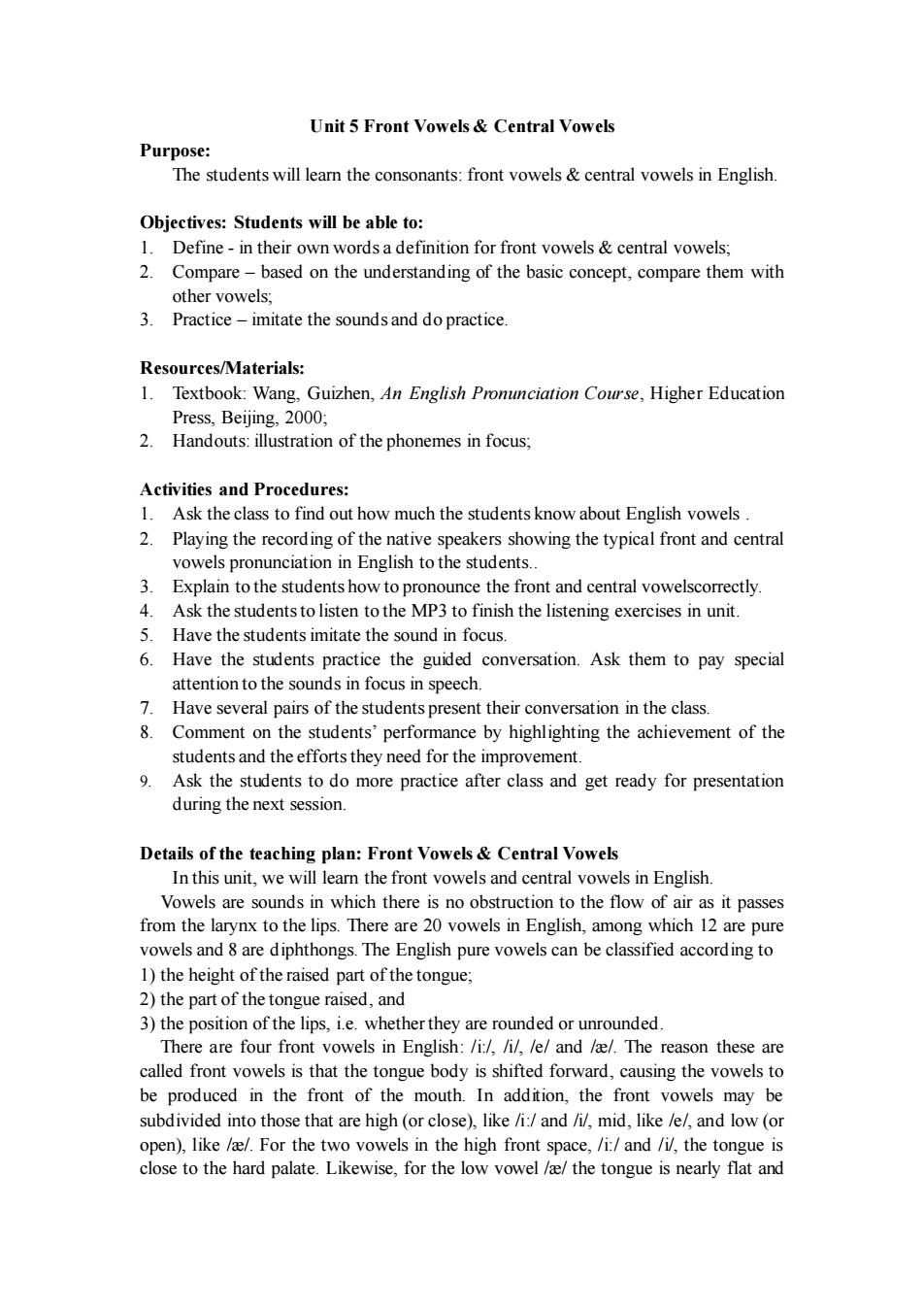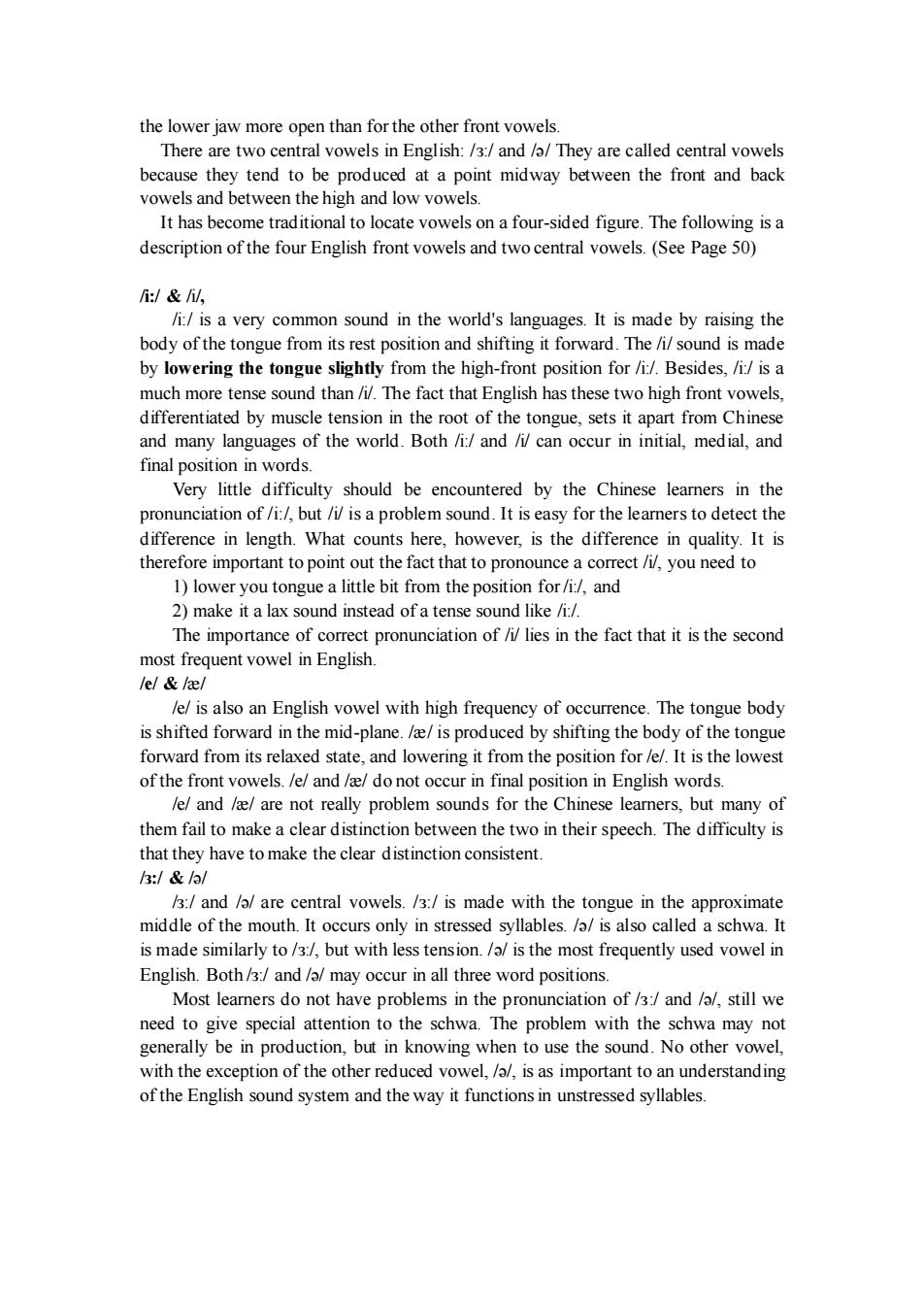
Unit 5 Front Vowels Central Vowels Purpose: The students will leam the consonants:front vowels central vowels in English. Objectives:Students will be able to: 1.Define-in their own words a definition for front vowels central vowels: 2.Compare based on the understanding of the basic concept,compare them with other vowels, 3.Practice-imitate the soundsand do practice. Resources/Materials: 1.Textbook:Wang.Guizhen,An Engish Co Higher Education Press,Beijing.2000 2.Handouts:illustration of the phonemes in focus; Activities and Procedures: 1.Ask the class to find out how much the students know about English vowels 2. Playing the rec rding of the native speakers showing the typical front and central vowels pronunciation in English to the students. 3.Explain to the students how to pronounce the front and central vowelscorrectly. 4.Ask the students to listen to the MP3 to finish the listening exercises in unit. 5.Have the students imitate the sound in focus. 6. Have the students s practice the conversation.Ask them to pay special attention to the sounds in focus in speech. 7.Have several pairs of the students present their conversation in the class. 8.Comment on the students'performance by highlighting the achievement of the students and the efforts they need for the improvement. 9 Ask the students to do more practice after class and get ready for presentation during the next session Details of the teaching plan:Front Vowels Central Vowels In this unit,we will learn the front vowels and central vowels in English. Vowels are sounds in which there is no obstruction to the flow of air as it passes from the la x to the lips e20 owels in English, amo which 12 re pu upioa passe so aind s suo 1)the height of the raised part of the tongue; 2)the part of the tongue raised,and 3)the position of the lips,ie.whether they are rounded or unrounded. Ther are four front wels in English:e and /ae/.The reason these are caled is that the ton body shi ard,causing the vowels t be produced in the front of the mouth.In addition,the front vowels may be subdivided into those that are high (or close),like /i:/and /i/,mid,like /el,and low (or open).like /ae/.For the two vowels in the high front space,/i:/and /il,the tongue is close to the hard palate.Likewise,for the low vowel //the tongue is nearly flat and
Unit 5 Front Vowels & Central Vowels Purpose: The students will learn the consonants: front vowels & central vowels in English. Objectives: Students will be able to: 1. Define - in their own words a definition for front vowels & central vowels; 2. Compare – based on the understanding of the basic concept, compare them with other vowels; 3. Practice – imitate the sounds and do practice. Resources/Materials: 1. Textbook: Wang, Guizhen, An English Pronunciation Course, Higher Education Press, Beijing, 2000; 2. Handouts: illustration of the phonemes in focus; Activities and Procedures: 1. Ask the class to find out how much the students know about English vowels . 2. Playing the recording of the native speakers showing the typical front and central vowels pronunciation in English to the students. 3. Explain to the students how to pronounce the front and central vowelscorrectly. 4. Ask the students to listen to the MP3 to finish the listening exercises in unit. 5. Have the students imitate the sound in focus. 6. Have the students practice the guided conversation. Ask them to pay special attention to the sounds in focus in speech. 7. Have several pairs of the students present their conversation in the class. 8. Comment on the students’ performance by highlighting the achievement of the students and the efforts they need for the improvement. 9. Ask the students to do more practice after class and get ready for presentation during the next session. Details of the teaching plan: Front Vowels & Central Vowels In this unit, we will learn the front vowels and central vowels in English. Vowels are sounds in which there is no obstruction to the flow of air as it passes from the larynx to the lips. There are 20 vowels in English, among which 12 are pure vowels and 8 are diphthongs. The English pure vowels can be classified according to 1) the height of the raised part of the tongue; 2) the part of the tongue raised, and 3) the position of the lips, i.e. whether they are rounded or unrounded. There are four front vowels in English: /i:/, /i/, /e/ and /æ/. The reason these are called front vowels is that the tongue body is shifted forward, causing the vowels to be produced in the front of the mouth. In addition, the front vowels may be subdivided into those that are high (or close), like /i:/ and /i/, mid, like /e/, and low (or open), like /æ/. For the two vowels in the high front space, /i:/ and /i/, the tongue is close to the hard palate. Likewise, for the low vowel /æ/ the tongue is nearly flat and

the lower iaw more open than for the other front vowels Ther re two ntral vowels in English://and/They are called central vowels because they tend to be produced at a point midway between the front and back vowels and between the high and low vowels. It has become traditional to locate vowels on a four-sided figure.The following is a description of the four english front vowels and two central vowels.(See page 50) fi:/hil, /i:/is a very common sound in the world's languages.It is made by raising the body of the tongue from its rest position and shifting it forward.The /i/sound is made by lowering the tongue slightly from the high-front position for/i/.Besides,/i:/is a much more tense sound than/i/.The fact that English has these two high front vowels. differentiated by musce ension oot of the tongue,sets it apar fron and many languages of the world.Both/i/and /i/can occur in initial,medial,and final position in words. Very little difficulty should be encountered by the Chinese leamers in the pronunciation of/i:/,but/i/is a problem sound.It is easy for the learners to detect the however,is the diffe v.It is errtoo the factthattopnounmet you need to 1)lower you tongue a little bit from the position for/i:/,and 2)make it a lax sound instead of a tense sound like /i/. The importance of correct pronunciation of/i/lies in the fact that it is the second most frequent vowel in English. /e/is also an English vowel with high frequency of occurrence.The tongue body is shifted forward in the mid-plane./ae/is produced by shifting the body of the tongue forward from its relaxed state,and lowering it from the position for /e/.It is the lowest of the front vowels./e/and/a/do not occur in final position in English words. lel and ael are n bler sounds for the Chi es rs but many of them fail to make a clear distinction between the two in their speech.The difficulty is that they have to make the clear distinction consistent. :/&l /3:/and /a/are central vowels./3:/is made with the tongue in the approximate middle of the mouth.It occurs only in stressed syllables./a schwa.It is made simi arly to/but with less tension.is the most frequently used vowel in English.Both/:/and /a/may occur in all three word positions. Most learners do not have problems in the pronunciation of/3:/and /a/,still we need to give special attention to the schwa.The problem with the schwa may not generally be in production,but in knowing when to use the sound.No other vowel, of the ther el,lal,is a as important to a derstanding of the English sound system and the way it functions in unstressed syllables
the lower jaw more open than for the other front vowels. There are two central vowels in English: /з:/ and /ə/ They are called central vowels because they tend to be produced at a point midway between the front and back vowels and between the high and low vowels. It has become traditional to locate vowels on a four-sided figure. The following is a description of the four English front vowels and two central vowels. (See Page 50) /i:/ & /i/, /i:/ is a very common sound in the world's languages. It is made by raising the body of the tongue from its rest position and shifting it forward. The /i/ sound is made by lowering the tongue slightly from the high-front position for /i:/. Besides, /i:/ is a much more tense sound than /i/. The fact that English has these two high front vowels, differentiated by muscle tension in the root of the tongue, sets it apart from Chinese and many languages of the world. Both /i:/ and /i/ can occur in initial, medial, and final position in words. Very little difficulty should be encountered by the Chinese learners in the pronunciation of /i:/, but /i/ is a problem sound. It is easy for the learners to detect the difference in length. What counts here, however, is the difference in quality. It is therefore important to point out the fact that to pronounce a correct /i/, you need to 1) lower you tongue a little bit from the position for /i:/, and 2) make it a lax sound instead of a tense sound like /i:/. The importance of correct pronunciation of /i/ lies in the fact that it is the second most frequent vowel in English. /e/ & /æ/ /e/ is also an English vowel with high frequency of occurrence. The tongue body is shifted forward in the mid-plane. /æ/ is produced by shifting the body of the tongue forward from its relaxed state, and lowering it from the position for /e/. It is the lowest of the front vowels. /e/ and /æ/ do not occur in final position in English words. /e/ and /æ/ are not really problem sounds for the Chinese learners, but many of them fail to make a clear distinction between the two in their speech. The difficulty is that they have to make the clear distinction consistent. /з:/ & /ə/ /з:/ and /ə/ are central vowels. /з:/ is made with the tongue in the approximate middle of the mouth. It occurs only in stressed syllables. /ə/ is also called a schwa. It is made similarly to /з:/, but with less tension. /ə/ is the most frequently used vowel in English. Both /з:/ and /ə/ may occur in all three word positions. Most learners do not have problems in the pronunciation of /з:/ and /ə/, still we need to give special attention to the schwa. The problem with the schwa may not generally be in production, but in knowing when to use the sound. No other vowel, with the exception of the other reduced vowel, /ə/, is as important to an understanding of the English sound system and the way it functions in unstressed syllables